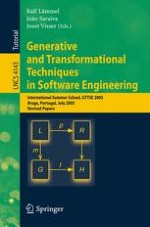2006 | Buch
Generative and Transformational Techniques in Software Engineering
International Summer School, GTTSE 2005, Braga, Portugal, July 4-8, 2005. Revised Papers
herausgegeben von: Ralf Lämmel, João Saraiva, Joost Visser
Verlag: Springer Berlin Heidelberg
Buchreihe : Lecture Notes in Computer Science
